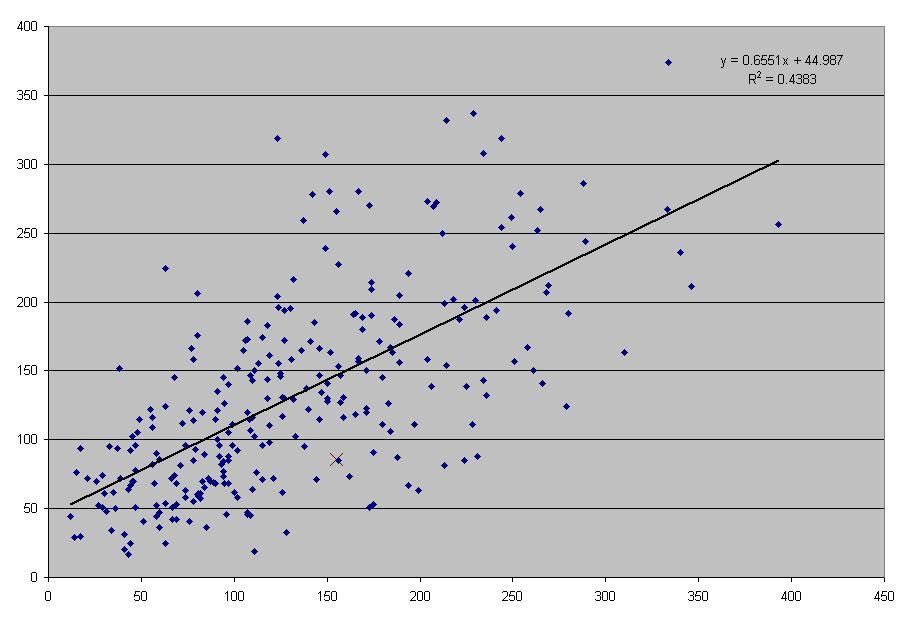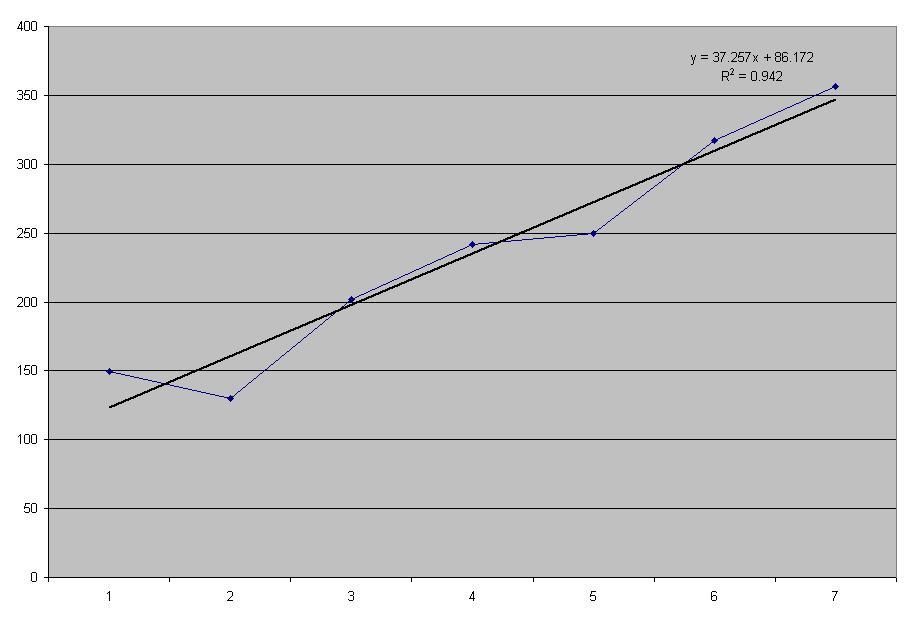Post by eric on Jul 2, 2015 16:10:24 GMT -6
Injuries can derail even the best teams. Is there any way to avoid them?
No.
.
I simulated an identical league 40 times, then I did so again after changing a single player's attributes from all 5s to all 100s. If avoiding injury is an ability rather than luck, we should see correlation from one sample to the other, and we do:

However, note the location of the red X near (150,100). That's the player I changed, and the blue diamond directly next to him was a player identical from year to year (Zarko Cabarkapa, who as a Montenegrin NOT named Nikola couldn't hack it in the NBA). This suggests attributes aren't relevant, especially since the numbers of games missed in the second season is on the x-axis; that is, the superman missed more games than the milquetoast. To be sure, let's do a linear regression of every characteristic against games missed and see how our R^2 looks:
Outside of Age (and therefore Experience) and CurrentRating, there's no correlation about 0.1, so what's the deal? How are the two samples consistent with each other? If we bin out players by combined minutes per game, we get...

That is, the more minutes a player plays the more likely he is to hurt himself. This makes sense, and playing time is very consistent for a given player. If we look at only the players who played between 50 and 60 combined minutes per game (so averaging 25-30), we get...
Again, Age and CurrentRating are the identifiable parameters. Old players get hurt more, better players play more and therefore get hurt more. No individual attribute (or even rating) can unilaterally define a better player, so none of them have significant R^2s. This also means there's nothing you can do to keep your player from getting injured except not play him, but on the plus side there's no such thing as an injury-prone player. There's just no field for it in the program, and because no existing attribute has that effect it does not exist.
It's all luck.
A curiosity: there were no iron men in either 40 year sample. Everyone ended up missing games sooner or later. The fewest games missed in the first sample was 17 by Stanislav Medvedenko (missed no more than 5 in a given season), second sample was 12 by Joel Przybilla (missed no more than 6 in a given season). In the opposite sample, Slava missed 43 and Joel missed 44... not even good enough for top ten.
No.
.
I simulated an identical league 40 times, then I did so again after changing a single player's attributes from all 5s to all 100s. If avoiding injury is an ability rather than luck, we should see correlation from one sample to the other, and we do:

However, note the location of the red X near (150,100). That's the player I changed, and the blue diamond directly next to him was a player identical from year to year (Zarko Cabarkapa, who as a Montenegrin NOT named Nikola couldn't hack it in the NBA). This suggests attributes aren't relevant, especially since the numbers of games missed in the second season is on the x-axis; that is, the superman missed more games than the milquetoast. To be sure, let's do a linear regression of every characteristic against games missed and see how our R^2 looks:
all characteristic
0.006 Height
0.002 Weight
0.311 Age
0.000 PositionNumber
0.333 Experience
0.049 Potential
0.044 KnownPotential
0.076 InsideScoring
0.046 JumpShot
0.015 ThreePointShot
0.011 Scoring
0.005 Handling
0.072 Passing
0.002 Quickness
0.018 PostDefense
0.023 PerimeterDefense
0.012 DriveDefense
0.011 Stealing
0.000 ShotBlocking
0.001 OffenseRebound
0.015 DefenseRebound
0.003 Strength
0.004 Jumping
0.051 RatingInsideScoring
0.026 RatingOutsideScoring
0.053 RatingHandling
0.038 RatingDefense
0.003 RatingRebounding
0.163 CurrentRating
0.027 FutureRatingOutside of Age (and therefore Experience) and CurrentRating, there's no correlation about 0.1, so what's the deal? How are the two samples consistent with each other? If we bin out players by combined minutes per game, we get...

That is, the more minutes a player plays the more likely he is to hurt himself. This makes sense, and playing time is very consistent for a given player. If we look at only the players who played between 50 and 60 combined minutes per game (so averaging 25-30), we get...
tier 5 characteristic
0.030 Height
0.009 Weight
0.703 Age
0.003 PositionNumber
0.659 Experience
0.116 Potential
0.085 KnownPotential
0.057 InsideScoring
0.088 JumpShot
0.000 ThreePointShot
0.014 Scoring
0.066 Handling
0.041 Passing
0.010 Quickness
0.033 PostDefense
0.002 PerimeterDefense
0.005 DriveDefense
0.003 Stealing
0.000 ShotBlocking
0.007 OffenseRebound
0.015 DefenseRebound
0.005 Strength
0.020 Jumping
0.024 RatingInsideScoring
0.006 RatingOutsideScoring
0.029 RatingHandling
0.000 RatingDefense
0.000 RatingRebounding
0.112 CurrentRating
0.193 FutureRatingAgain, Age and CurrentRating are the identifiable parameters. Old players get hurt more, better players play more and therefore get hurt more. No individual attribute (or even rating) can unilaterally define a better player, so none of them have significant R^2s. This also means there's nothing you can do to keep your player from getting injured except not play him, but on the plus side there's no such thing as an injury-prone player. There's just no field for it in the program, and because no existing attribute has that effect it does not exist.
It's all luck.
A curiosity: there were no iron men in either 40 year sample. Everyone ended up missing games sooner or later. The fewest games missed in the first sample was 17 by Stanislav Medvedenko (missed no more than 5 in a given season), second sample was 12 by Joel Przybilla (missed no more than 6 in a given season). In the opposite sample, Slava missed 43 and Joel missed 44... not even good enough for top ten.










